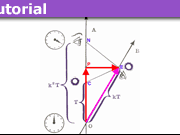Can I Send a Signal Faster than Light by Pushing a Rigid Rod?
One common proposal for achieving faster than light communication is to use a long perfectly rigid object and mechanically send signals to the other end by pushing, pulling, or tapping it. For instance; a hypothetical rigid rod linking two people several lightyears away. The fundamental idea is that when one end is moved the other end is disturbed instantaneously.
However, there is no such thing as a perfectly rigid rod: a mechanical disturbance at one end of any material can only move through the material at a finite speed. This speed is called the speed of sound in that material.
High stiffness materials like metal have a very high speed of sound and low stiffness materials like jello or air have a very low speed of sound. When you push on something made of jello, you can easily see that the disturbance propagates at a finite speed. When you push on something like metal, it is not so easy to see visually, but the disturbance still propagates at the finite speed of sound in the metal. (see e.g. https://www.physicsforums.com/showthread.php?p=4414855#post4414855)
The speed of sound in a diamond is about 12000 m/s which is about 25 thousand times slower than the speed of light (299792458 m/s). But what about some hypothetical “unobtainium”? Why couldn’t unobtainium’s speed of sound be faster than the speed of light? The answer is that all materials, even unobtainium, are held together by electromagnetic forces at the molecular level. When one molecule moves then the change in its electromagnetic field propagates to its neighboring molecule at the speed of light. So even in principle, it is not possible for any material to have a speed of sound faster than the speed of light.
The following forum members have contributed to this FAQ:
DaleSpam
Ryan_m_b
DrGreg
tiny-tim
with additional review and discussion by several others
This article was authored by several Physics Forums members with PhDs in physics or mathematics.








Consider how would you test the propagation velocity in a 'perfectly rigid' material? You would need a signal device to tell you when the distant end of your hypothetical rod moved, was pushed, etc. The receiving end of your detector would need to acknowledge the signal before the near end of the rod moved. The only possible non null result would be If the near end of the rod moved before the signal registered, which would only prove the reaction time [hysteresis] of your signaling system was slower than the propagation speed of your 'perfectly rigid' material. This is reminiscent of Galileo's attempt to measure the speed of light using lanterns on distant hills. He concluded he was only measuring the reaction times of his students and the speed of light was very much faster [possibly infinite], which was entirely logical given the measurement precision possible in his test setup.
[QUOTE="Dale, post: 5629728, member: 43978"]There have been 23 posts deleted, one full ban, and one thread ban. The forum rules apply here and they apply to you![/QUOTE]Now 29 posts, one full ban, and 2 thread bans. All of the forum rules apply!
[QUOTE="PeterDonis, post: 5634097, member: 197831"]No, it isn't, it's describing a congruence of worldlines that has zero expansion and shear. The fact that the entire congruence of worldlines is determined once we specify one of them does not mean it's just one worldline.[/QUOTE]You can consider the entire congruence but what is the point is my question if it also describes a material point worldline wich is a simpler object and has direct linking to point particles of QFT. Let's use some physical Ockham razor here.
[QUOTE="RockyMarciano, post: 5634089, member: 585697"]The math is actually describing the acceleration of a material point[/QUOTE]No, it isn't, it's describing a congruence of worldlines that has zero expansion and shear. The fact that the entire congruence of worldlines is determined once we specify one of them does not mean it's just one worldline.
[QUOTE="PeterDonis, post: 5634068, member: 197831"]It depends on how you interpret "constant proper acceleration". It is perfectly possible to have an object undergoing constant proper acceleration that is Born rigid, as long as we are clear that "constant proper acceleration" means "the proper acceleration of any given point inside the object is constant, but different points can have different constant proper acceleration".[/QUOTE]This is fine, but if the acceleration of the "body" is completely determined by one of its points' three degrees of freedom, what is the point in calling it a "rigid body" or "rigid rod" or implying we are referring to an extended body in general. The math is actually describing the acceleration of a material point, why pretend it is about rigid bodies we are talking about in this accelerated case?
[QUOTE="RockyMarciano, post: 5634056, member: 585697"]Born rigidity is broken under constant proper acceleration[/QUOTE]It depends on how you interpret "constant proper acceleration". It is perfectly possible to have an object undergoing constant proper acceleration that is Born rigid, as long as we are clear that "constant proper acceleration" means "the proper acceleration of any given point inside the object is constant, but different points can have different constant proper acceleration". In other words, the object's worldlines describe a Rindler congruence. This is the kind of motion Ibix was describing.If "constant proper acceleration" means "the proper acceleration of every point inside the object is constant and exactly the same", then you are correct that such a motion is not Born rigid. This set of worldlines describes a Bell congruence, which has a positive expansion (and this fact is why the string stretches and finally breaks in the Bell spaceship paradox).The most general theorem on the requirements for Born rigid motion is the Herglotz-Noether theorem. A reasonable summary of what the theorem says is in the posts by myself and PAllen in this thread:https://www.physicsforums.com/threads/herglotz-noether-theorem-understanding.711793/
[QUOTE="PeterDonis, post: 5633515, member: 197831"]Where?[/QUOTE]Don't remember, it was long ago, and the slinky example has cleared up my thinking. And even if the two ends did respond to letting go and gravity "simultaneously" I still don't think it would qualify as FTL.
[QUOTE="Ibix, post: 5632825, member: 365269"]I think it's worth reading the context before taking any statement at face value. Especially from that thread. It's a very confusing thread.I think that Peter was pointing out that it is perfectly possible to have objects that behave rigidly by Born's definition under steady acceleration. That's enough for Einstein's purposes (building a grid of unaccelerated rods to use as a coordinate system), but isn't enough to transmit faster than light. That would require rigidity under varying acceleration as well.[/QUOTE]I think when you wrote steady acceleration you meant uniform straight motion, since Born rigidity is broken under constant proper acceleration and when you wrote varying acceleration you meant varying speed.I agree the thread was confusing or at least the statements of several posters made no sense to me. Since they are on topic in this thread I'll comment on them, IMHO getting the math right solves confusions most of the time. For instance it was stated in that thread that in situations that didn't involve rigid bodies subjected to a force in the manner the insigths article refers to (i.e. pushing the rod), Born rigidity allowed existence of rigid bodies in SR and their motion under certain restricted circumstances, like for instance pure lorentz boosts. It is true that Born rigidity motion that only involves three degrees of fredom is compatible with pure lorentz boost with the same d.o.f.It is not correct that Lorentz transformations in the way they are understood in physics, i.e. the identity component of the group, that preserves both space and time orientation and that has six degrees of freedom is compatible with Born rigidity, there are just three d.o.f. missing. A pure boost(that is not connected continuously to the identity and therefore doesn't preserve causality unless the assumption is added independent of the mathematics like it is done in the standard undergraduate SR texts) is just not enough to convey the richness of physical (causal) Lorentzian transformations for extended rods to be valid objects in SR. You could maybe say a very limited motion (rotation-free boosts) is allowed in Minkowski spacetime, but the geometry of Minkowski spacetime is not exactly isomorphic to the physics of SR.
[QUOTE="Chris Miller, post: 5633007, member: 608318"]I read somewhere[/QUOTE]Where?
[QUOTE="Chris Miller, post: 5633028, member: 608318"]Thanks. No need. The term "slinky drop" clears up my thinking.[/QUOTE]Since you asked earlier, I'm going to use you as an example of why I advocated for leaving this thread open. It isn't always easy to tell from the first post whether someone legitimately doesn't understand the mechanics behind what happens – the fact that a long metal rod behaves very similarly to a slack spring. But it is almost always clear from the second post, when either the person gets combative or in your case, the light bulb goes on. On this particular topic it takes an awful lot of effort to keep the noise down so we can help people like you are are trying to learn. So thanks for saying thanks.
[QUOTE="A.T., post: 5632925, member: 85613"]Well said. I wish the other Russ Watters would have the same insight:https://www.physicsforums.com/threads/relativistic-tips-of-a-propeller.861028/#post-5403578[/QUOTE]You and I really weren't very far apart there, A.T. I think we both recognize that making appropriate impossible assumptions is a critical component of problem (even thought problem) solving, we just disagreed on where to draw the line on what assumptions were acceptable and what aren't. Your position (and you are welcome to it) was that any non-physical assumption falling under the header "Special Relativity" should be unacceptable in a problem where the answer depends on SR. My position is that SR is a broad theory, with lots of components that can be addressed separately. It's a judgement call and we'll just have to agree to disagree.[edit] Also, one component of dealing with assumptions is recognizing if they are relevant or even necessary and constructing thought experiments in such a way as to avoid tripping over them. Most of these "what if…" thought experiments have multiple points of failure and you can construct the helicopter one in such a way as to avoid the use of the "infinitely rigid" assumption. That is part of the reason I put it on the other side of that line.
[QUOTE="Ibix, post: 5629839, member: 365269"]Exactly. The matter in the rod has to be held together by some force, and they all propagate at or below the speed of light. So a "but what if…" question boils down to "what if magic happens?" In which case "the rod turns into a flock of unicorns" is an equally reasonable answer.I'm sure someone on this forum actually did this experiment a year or two back. He set up a metal bar with a couple of strain gauges along it then whacked one end with a hammer and showed that the other end didn't move for a couple of milliseconds. My search-fu is failing me, though.[/QUOTE]This was bobc2 here: https://www.physicsforums.com/showthread.php?p=4414855#post4414855I have a link to that post in the body of the insights article.
[QUOTE="Nugatory, post: 5633021, member: 382138"]But even setting aside the relativistic problems with stating exactly what is happening…. Check some of the youtube videos you'll find under the topic "slinky drop".[/QUOTE]Thanks. No need. The term "slinky drop" clears up my thinking.
[QUOTE="Chris Miller, post: 5633007, member: 608318"]Probably nothing in which a compression wave is faster than light. But I read somewhere that the ends of long rod pointing downward will move simultaneously when the rod is released.[/QUOTE]Will move simultaneously in which frame? If the rod is being held at the top, what exactly does "when the rod is released" mean for the bottom end?But even setting aside the relativistic problems with stating exactly what is happening…. Check some of the youtube videos you'll find under the topic "slinky drop".
Probably nothing in which a compression wave is faster than light. But I read somewhere that the ends of long rod pointing downward will move simultaneously when the rod is released.EDITAlthough, a diamond is pretty fluffy compared to the primordial universe (quark-gluon plasma) or even a neutron star. Wonder what the speed of sound in those would be…
[QUOTE="russ_watters, post: 5632664, member: 142"]The problems generally occur when someone insists on applying the impossible assumption of an infinitely rigid rod and won't let it go. You can't give a meaningful answer to a question based on a nonsensical premise[/QUOTE]Well said. I wish the other Russ Watters would have the same insight:https://www.physicsforums.com/threads/relativistic-tips-of-a-propeller.861028/#post-5403578
[QUOTE="RockyMarciano, post: 5632345, member: 585697"]All this is clear enough and I don't know what the controversy could be. Everyone agrees there are no rigid rods.Perhaps people gets confused because there are some contradictory messages by regulars that claim that this conclusion that is agreed here as the only that makes sense is not correct. I found some such postings in a search of the last year only. Disregarding the context of the discussion wich I haven't read completely this is an example: https://www.physicsforums.com/threads/why-arent-standard-rods-and-clocks-affected-by-lc-and-td.854826/page-2 posts 24# and 39# where it seems a ban was given for claiming what is claimed in this insights article.[/QUOTE]I think it's worth reading the context before taking any statement at face value. Especially from that thread. It's a very confusing thread.I think that Peter was pointing out that it is perfectly possible to have objects that behave rigidly by Born's definition under steady acceleration. That's enough for Einstein's purposes (building a grid of unaccelerated rods to use as a coordinate system), but isn't enough to transmit faster than light. That would require rigidity under varying acceleration as well.
[QUOTE="RockyMarciano, post: 5632345, member: 585697"]All this is clear enough and I don't know what the controversy could be. Everyone agrees there are no rigid rods.[/QUOTE]The problems generally occur when someone insists on applying the impossible assumption of an infinitely rigid rod and won't let it go. You can't give a meaningful answer to a question based on a nonsensical premise and even if you just dropped all connection to facts and logic and answered "yes", it still isn't a useful or meaningful answer and is beyond the scope of the forum anyway. It's fantasy pretending to be science.At the risk of drawing the ire of the other moderators, I'm going to quote a post of mine that was deleted due to it being a response to just such a member:"Many people who ask the question don't know that the question itself contains an error. So answering the question as-is (yes: a hypothetical perfectly rigid rod could be used to send a signal FTL) might inadvertently confirm their erroneous understanding of how reality works. That's why one should always correct the question before answering it."And often people who refuse to drop the assumption end up later proving to be first-order crackpots.
[QUOTE="Battlemage!, post: 5629734, member: 135434"]Question: wouldn't the assumption of a perfectly rigid rod automatically change the rules anyway? Since how can energy transfer through the rod if the atoms inside of it don't move back and forth? If the atoms vibrate doesn't that cause absurdly tiny changes in the size of the rod? (I wouldn't know: I am not sure how macroscopic shape arises from microscopic arrangement of atoms).So I guess basically it seems that the only way for a rod to be perfectly rigid would be for it to be made out of some non-physical material, right? And if we're going that far why even keep a pretense of physics in the first place?[/QUOTE][QUOTE="Ibix, post: 5629839, member: 365269"]Exactly. The matter in the rod has to be held together by some force, and they all propagate at or below the speed of light. So a "but what if…" question boils down to "what if magic happens?" In which case "the rod turns into a flock of unicorns" is an equally reasonable answer.[/QUOTE]All this is clear enough and I don't know what the controversy could be. Everyone agrees there are no rigid rods.Perhaps people gets confused because there are some contradictory messages by regulars that claim that this conclusion that is agreed here as the only that makes sense is not correct. I found some such postings in a search of the last year only. Disregarding the context of the discussion wich I haven't read completely this is an example: https://www.physicsforums.com/threads/why-arent-standard-rods-and-clocks-affected-by-lc-and-td.854826/page-2 posts 24# and 39# where it seems a ban was given for claiming what is claimed in this insights article.
Well, this signal propagates with the speed of sound in that medium, which is way smaller than the speed of light anyway.
Exactly. The matter in the rod has to be held together by some force, and they all propagate at or below the speed of light. So a "but what if…" question boils down to "what if magic happens?" In which case "the rod turns into a flock of unicorns" is an equally reasonable answer.I'm sure someone on this forum actually did this experiment a year or two back. He set up a metal bar with a couple of strain gauges along it then whacked one end with a hammer and showed that the other end didn't move for a couple of milliseconds. My search-fu is failing me, though.
Question: wouldn't the assumption of a perfectly rigid rod automatically change the rules anyway? Since how can energy transfer through the rod if the atoms inside of it don't move back and forth? If the atoms vibrate doesn't that cause absurdly tiny changes in the size of the rod? (I wouldn't know: I am not sure how macroscopic shape arises from microscopic arrangement of atoms).Another question: Since all atoms are held together by electromagnetic forces, wouldn't the speed limit of a signal through the rod already be automatically capped by the vacuum speed of light?So I guess basically it seems that the only way for a rod to be perfectly rigid would be for it to be made out of some non-physical material, right? And if we're going that far why even keep a pretense of physics in the first place?
After some discussion, this thread is reopened. Please review the forum rules before posting. There have been 23 posts deleted, one full ban, and one thread ban. The forum rules apply here and they apply to you!
Evidently it is well nigh impossible for people to respond to this Insights article without going out of bounds. Therefore, this thread is closed.
[QUOTE="thhog, post: 5628794, member: 609795"]I do hope that hypotethical questions are allowed.[/QUOTE]Not ones that violate the laws of physics. A "perfectly rigid" rod violates the laws of physics (and the Insights article explains why).[QUOTE="thhog, post: 5628794, member: 609795"]What specific laws of nature will be violated and in what way?[/QUOTE]The law that causal influences can't propagate faster than light. (QM entanglement does not violate this law, btw.)
I do hope that hypotethical questions are allowed. So my hypotethical rod is made of some exotic stuff (a bunch of entangled particles or …?) and therefore perfectly rigid. Obviously you will be able to transmit a tap directly over any distance. Then the question will be; can such a rod be inserted/created in our universe? What specific laws of nature will be violated and in what way? Do we have to choose between the universe and the rod? As I understand it, the rod can't be described within the current set of geometrical/mathematical statements describing our universe. Does that mean that the description of such an object will make all current statements logically false and prohibit any logical matematica/geometrical consistent description of our universe?
You could, but there’s no way for the rank and file to know when a member is banned.
Y’know…. There’s an old English-language proverb about the futility of beating a dead horse. Do we need to update it to say something about beating a banned member?
[QUOTE=”Byron Brubaker, post: 5239707, member: 562156″]If that is the case then ‘what-if’ questions should never be asked in the first place.[/QUOTE]
No, it just your question. If the premise of a question is making any possible answer irrelevant, then it is indeed a pointless question.
The actual experiment [URL=’https://www.physicsforums.com/threads/question-about-instantaneous-travel-of-information-on-a-solid.696067/#post-4414855′]was done and the data shown[/URL]. This is linked in the thread. It shows that when you push a rigid rod, electrical impulses (which travel at about 2/3 of the speed of light) travel faster than the opposite end of the rod. Ignoring the experimental data when making your argument is un-scientific.
In the past, discussions of this nature were not allowed on PF – how can you have a scientific discussion when one person refuses to consider experiment? It’s not like there is a complicated chain of inference here – it’s the actual experiment: push one end of the rod and see when the other end moves.
[QUOTE=”Byron Brubaker, post: 5239742, member: 562156″]
The question was dealing with ‘faster-than-light’ now we’re on ‘speed of sound?’ I’ll rebut with my own question to get away from constants and ‘not violate the almighty thread rules’; What’s the limit to/of “SPEED?”[/QUOTE]
Rather than stamping your feet and insulting people who are trying to help you, have you considered doing some basic research yourself? Your question is not rocket science.
[QUOTE=”Byron Brubaker, post: 5239742, member: 562156″]Speed of light in space vacuum is a CONSTANT, NOT A LIMIT TO SPEED! Anyone have a problem with that statement?
The question was dealing with ‘faster-than-light’ now we’re on ‘speed of sound?’ I’ll rebut with my own question to get away from constants and ‘not violate the almighty thread rules’; What’s the limit to/of “SPEED?”[/QUOTE]
The speed, for instance of the intersection of a pair of scissors? Of the illuminated spot of a laser pointer being swept across the moon? Or of a signal originated over here, and being transmitted somewhere over there?
[QUOTE=”Byron Brubaker, post: 5239742, member: 562156″]The question was dealing with ‘faster-than-light’ now we’re on ‘speed of sound?'[/QUOTE]
Yes, that’s still the wrong/a poor question. The right question is: what is the maximum speed of a signal propagating through an object like a rod? And the answer is: the speed of sound.
[quote] What’s the limit to/of “SPEED?”[/quote]
The maximum speed of an object with mass is just under (asymptotically) the speed of light. Or, if one prefers, the speed of light is the speed limit of the universe.
[misinformation deleted by mod]
[QUOTE=”russ_watters, post: 5239736, member: 142″]What math, exactly, would you like to see? Did you read the insight article and the thread linked in it? The math for calculating the speed of sound in a material is shown in the thread.[/QUOTE]
The question was dealing with ‘faster-than-light’ now we’re on ‘speed of sound?’ I’ll rebut with my own question to get away from constants and ‘not violate the almighty thread rules’; What’s the limit to/of “SPEED?”
[QUOTE=”Byron Brubaker, post: 5239730, member: 562156″]I can deal with that statement. When a person points it out all h*ll breaks loose. I’d like to see the math from anyone proving the improbability of the hypothetical question rather than just being told ‘well, it’s impossible.'[/QUOTE]
What math, exactly, would you like to see? Did you read the insight article and the thread linked in it? The math for calculating the speed of sound in a material is shown in the thread.
I state a historical FACT and it was deleted by admin also.
[QUOTE=”russ_watters, post: 5239722, member: 142″]I think you are missing the point. Many people who ask the question [B]don’t know[/B] that the question itself contains an error. So answering the question as-is (yes: a hypothetical perfectly rigid rod could be used to send a signal FTL) might inadvertently confirm their erroneous understanding of how reality works. That’s why one should always correct the question before answering it.[/QUOTE]
I can deal with that statement. When a person points it out all h*ll breaks loose. I’d like to see the math from anyone proving the improbability of the hypothetical question rather than just being told ‘well, it’s impossible.’
“Hi Byron Brubaker,
In regards to your thread/post: [URL=’https://www.physicsforums.com/posts/5239472/’]Can I Send a Signal Faster than Light by Pushing a Rigid Rod? – Comments[/URL]
While reviewing your post we’ve found you are stubbornly promoting content that is false or misguided.
Please view our [URL=’https://www.physicsforums.com/threads/physics-forums-global-guidelines.414380/’][B]forum rules[/B][/URL] guidelines for more information.
Thanks for your understanding and participation at Physics Forums!
Orodruin”
Would you mind being specific in your claims? The thread does not show what I am being chastised for nor does your claim hold any validity. Show me proof that I “stubbornly promoted content that is false or misguided.” If you think you have absolute proof please, by all means back up what you say. My email is [EMAIL]mx6maximus@gmail.com[/EMAIL]
[QUOTE=”Byron Brubaker, post: 5239707, member: 562156″]If that is the case then ‘what-if’ questions should never be asked in the first place.[/QUOTE]
There are many what-if questions that don’t hypothesize something that violates the laws of physics. Those can certainly be asked here.
[QUOTE=”Byron Brubaker, post: 5239707, member: 562156″]If that is the case then ‘what-if’ questions should never be asked in the first place. The thing worse than a know-it-all is a know-almost.[/QUOTE]
I think you are missing the point. Many people who ask the question [B]don’t know[/B] that the question itself contains an error. So answering the question as-is (yes: a hypothetical perfectly rigid rod could be used to send a signal FTL) might inadvertently confirm their erroneous understanding of how reality works. That’s why one should always correct the question before answering it.
[QUOTE=”PeterDonis, post: 5239470, member: 197831″]The “hypothetical rigid rod” is inconsistent with the laws of physics. There’s no point in asking what happens if the laws of physics are violated–at least not here on PF, where the only basis we have for giving an answer is the laws of physics.[/QUOTE]
If that is the case then ‘what-if’ questions should never be asked in the first place. The thing worse than a know-it-all is a know-almost.
From the Insights post:
[INDENT][I]”The speed of sound in diamond is about 12000 m/s which is about 25 thousand times slower than the speed of light (299792458 m/s). But what about some hypothetical “unobtainium”? Why couldn’t unobtainium’s speed of sound be faster than the speed of light?”[/I]
[/INDENT]
I suppose technically you can say that there *are* materials where the speed of sound, or at least the speed of matter, exceeds the speed of light [I]in that material/medium; [/I]resulting of course in Cherenkov radiation. In a periodic material like a crystal you have the Smith-Purcell effect.
Of course you’d never get the propagation of a signal through the medium to exceed the speed of light in a vacuum.
[QUOTE=”PAllen, post: 5239511, member: 275028″]What would you want? Once you posit something for which there is no evidence, and which is inconsistent with known physical law, there is no answer that could be given. Make up whatever you like. For example:
Suppose I could move objects with my mind. What would the weight limit be?
On what basis is such a question to be answered? Certainly not on the basis of science. Similarly, your hypothetical rigid rod is simply outside of science. Therefore, write any fiction you want.[/QUOTE]
I can move objects with my mind. The weight limit is dependent on the maximum weight you can lift after I tell you to “pick that up.”
Keep speed relative to size depending on your perception (micro/macro) There are no laws being broken.
[QUOTE=”Byron Brubaker, post: 5239472, member: 562156″]You validated my point, thank you.[/QUOTE]
What would you want? Once you posit something for which there is no evidence, and which is inconsistent with known physical law, there is no answer that could be given. Make up whatever you like. For example:
Suppose I could move objects with my mind. What would the weight limit be?
On what basis is such a question to be answered? Certainly not on the basis of science. Similarly, your hypothetical rigid rod is simply outside of science. Therefore, write any fiction you want.
[QUOTE=”PeterDonis, post: 5239470, member: 197831″]The “hypothetical rigid rod” is inconsistent with the laws of physics. There’s no point in asking what happens if the laws of physics are violated–at least not here on PF, where the only basis we have for giving an answer is the laws of physics.[/QUOTE]
You validated my point, thank you. Nikola Tesla transmitted electrical power longitudinally through the Earth at a velocity of 291,000 miles per second (pi/2*C ‘pi over two times the velocity of light’) Velocity of light is simply an expression of the ratio of energy to mass which is a constant not a limit.
[QUOTE=”Byron Brubaker, post: 5239464, member: 562156″]I’m still waiting on the answer for that “hypothetical rigid rod.”[/QUOTE]
The “hypothetical rigid rod” is inconsistent with the laws of physics. There’s no point in asking what happens if the laws of physics are violated–at least not here on PF, where the only basis we have for giving an answer is the laws of physics.
I’m still waiting on the answer for that “hypothetical rigid rod.” This is how these ‘physics experts’ grind my gears; Q; “Hypothetically?” A; “Here’s a few examples of reality why we can’t hypothetically.”
I think a good example for this would be to look at high speed photography of a golf ball being hit… As far as we can tell, the golf ball is solid, but high speed photography can show us it's really nothing more than jello if you hit it hard enough.
Could the speed of light be accelerated by a huge gravitational field? For example, we know light doesn't escape a black hole and is strong enough to cause lensing, therefore could it accelerate light if it complimented the light's path?